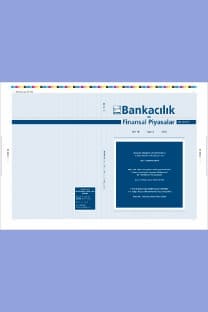Hisse Senedi Fiyatları ile Döviz Kuru İlişkisi: Gelişmekte Olan Ülkeler Üzerine Ampirik Bir Uygulama
The Relationship Between Stock Prices and Exchange Rates: An Empirical Study on Emerging Markets
___
- 1. Abdalla I., Murinde V., (1997). Exchange Rate and Stock Price Interactions in Emerging Financial Markets: Evidence on India, Korea, Pakistan and Philippines, Applied Financial Economics, vol. 7, 25 – 35
- 2. Ajayi R.A., Friedman J., Mehdian S.M. (1998). On the Relationship Between Stock Returns and Exchange Rates: Tests of Granger Causality, Global Finance Journal, vol 9, 241-251
- 3. Azman Saini W., Habibullah M., Azali M., (2003). Stock Price and Exchange Rate Dynamics: Evidence from Thailand, Savings and Development, vol 27(3), 245-258
- 4. Bahmani-Oskooee M., Sohrabian A., (1992). Stock Prices and Effective Exchange Rates of the Dollar, Applied Economics, vol 24(4), 459-464
- 5. Bartov E., Bodnar G.M., (1994). Firm Valuation, Earnings Expectations and the Exchange-Rate Exposure Effect, Journal of Finance, vol 49(5), 1755-1785
- 6. Bodnar, G.M., Gentry W.M., (1993). Exchange Rate Exposure and Industry Characteristics: Evidence from Canada, Japan and USA, Journal of International Money and Finance, vol 12(1), 29-45
- 7. Dickey, D.A., W.A., Fuller (1981). Likelihood Ratio Statistics for Autoregressive Time Series with A Unit Root, Econometrica, 49 (4), 1057-1072.
- 8. Doidge C., Griffin J., Williamson R., (2000). An International Comparison of Exchange Rate Exposure, Ohio State University Working Paper
- 9. Dornbush R., Fisher S., (1980). Exchange Rates and the Current Account, American Economic Review, vol. 70, 960-971
- 10. Engel, R.F., Granger, C.W.J. (1987). Co-integration and Error Correction Representation, Estimation and Testing, Econometrica, Vol. 55, No.2, pp. 251-276.
- 11. Giles, J.A., Mirza, S., (1998). Some Pretesting Issues on Testing for Granger Non-Causality. Econometric Working Papers, EWP9914, Department of Economics, University of Victoria, Canada.
- 12. Giles, J.A., Williams, C.I., (1999). Export-led Growth: A Survey of the Empirical Literature and Some Non-Causality Results. Econometric Working Paper EWP9901, Department of Economics, University of Victoria, Canada.
- 13. Granger, C.W.J. (1969). Investigating Causal Relations by Econometric Models and Cross-Spectral Methods, Econometrica, 37 (3) August, pp.424-438.
- 14. Gündüz L., Hatemi-J, A., (2002). On the Causal Relationship Between Stock Prices and Exchange Rates Evidence from MENA Region, FMA European Conference, 5-8 June, Copenhagen
- 15. Johansen, S. (1988). Statistical Analysis of Cointegration Vectors, Journal of Economic Dynamics and Control, Vol. 12, No. 2/3, pp. 231-254.
- 16. Johansen, S. And Juselius, K. (1990). Maximum Likelihood Estimation and Inference on Cointegration-With Applications to the Demand For Money, Oxford Bulletin of Economics and Statistics, Vol. 52, No. 2, pp.169-210.
- 17. Hatemi-J A., Irandoust M., (2002). On the Causality between Exchange Rates and the Current Account”, American Economic Review, Bulletin of Economic Research, vol 54(2), 197-203
- 18. He J., Ng L.K., (1998). The Foreign Exchange Exposure of Japanese Multinational Corporations, Journal of Finance, vol 53, 733-753
- 19. Granger C.W.J., Bwo-Nung H., Yang C., (2000). A Bivariate Causality between Stock Prices and Exchange Rates: Evidence From Recent Asia Flu, The Quarterly Review of Economics and Finance, vol. 40, 337-354
- 20. Jorion P., (1990). The Exchange Rate Exposure of U.S. Multinationals, Journal of Business, vol. 63, 331-345
- 21. Jorion P., (1991). The Pricing of Exchange Rate Risk in the Stock Market, Journal Financial and Quantitive Analysis, vol. 26, 363-376
- 22. Ma J.K., Kao G.W., (1990). On Exchange Rate Changes and Stock Price Reactions, Journal of Business Finance & Accounting, vol 17(3), 441-449
- 23. Mavrotas, G., Kelly, R., (2001). Old Wine In New Bottle: Testing Causality Between Savings And Growth, The Manchester School Supplement, pp. 97–105.
- 24. Nagayasu J. (2001). Currency Crisis and Contagion: Evidence from Exchange Rate and Sectoral Indices of the Philippines and Thailand, Journal of Asian Business, vol. 12, 529-546
- 25. Pesaran, M. H. Shin, Y. Smith, R.J., (2001). Bounds Testing Approaches to the Analysis of Level Relationships, Journal of Applied Econometrics, 16, pp.289-326
- 26. Phillips, P.C.B., Perron, P. (1988). Testing For A Unit Root In Time Series Regression. Biomètrika, 75 (2) 336-346.
- 27. Popper H., Chamberlain S., Howe J.S., (1996). The Exchange Rate Exposure of U.S. and Japanese Banking Institutions, Journal of Banking and Finance, vol 21, 871-892
- 28. Stavarek D. (2005). Linkages between Stock Prices and Exchange Rates in the EU and the United States, Czech Journal of Economics and Finance, vol. 55 (3-4), 141-161
- 29. Tang, T.C., (2003). Japanese Aggregate Import Demand Function: Reassessment from the Bounds Testing Approach, Japan and the World Economy, 15,419-436.
- 30. Toda, H.Y., Yamamoto, T., (1995). Statistical inference in vector auto regressions with possibly integrated process. Journal of Econometrics, 66, 225-250.
- ISSN: 1307-5705
- Yayın Aralığı: 2
- Başlangıç: 2007
- Yayıncı: Bankacılık Düzenleme ve Denetleme Kurumu
Determinants of Capital Structure in Financial Institutions: The Case of Turkey
The Bank Lending Channel In Turkey: Effect of Capital Adequacy Ratio
Cihan AKTAŞ, Bedri Kamil Onur TAŞ
Türkiye’de Banka Kredi Kanal›: Sermaye Yeterlilik Rasyosunun Etkisi
Cihan AKTAŞ, Bedri Kamil Onur TAŞ
Risk Yönetiminde Asimetrik Normal Karma GARCH Modelinin Öngörü Performansı: Türkiye Uygulaması
Türk Bankacılık Sektöründe Yoğunlaşma ve Rekabet: 1995-2005
Hisse Senedi Fiyatları ile Döviz Kuru İlişkisi: Gelişmekte Olan Ülkeler Üzerine Ampirik Bir Uygulama
